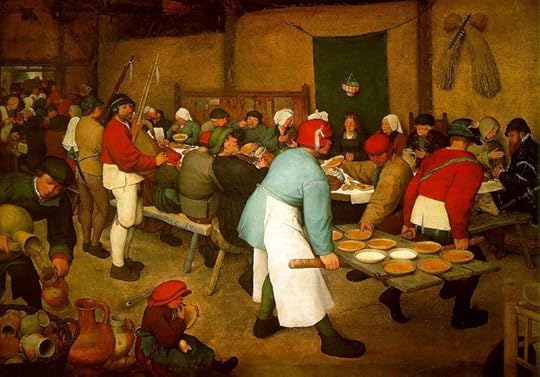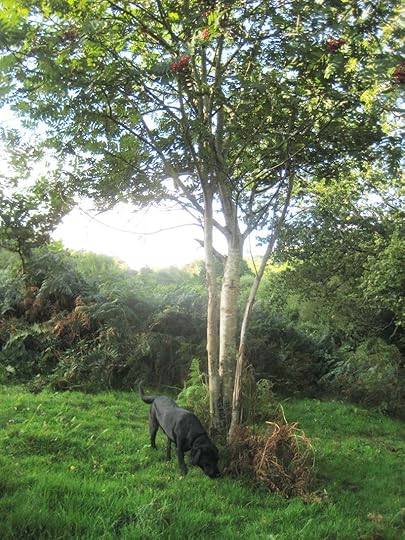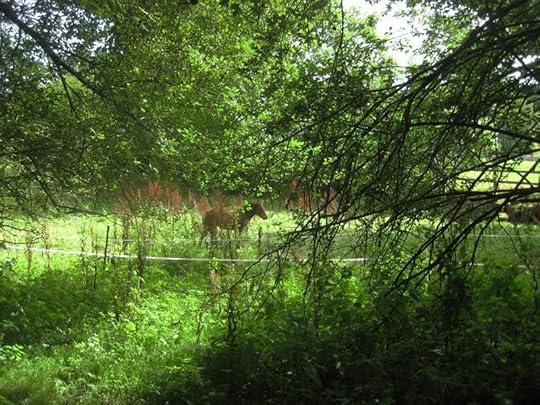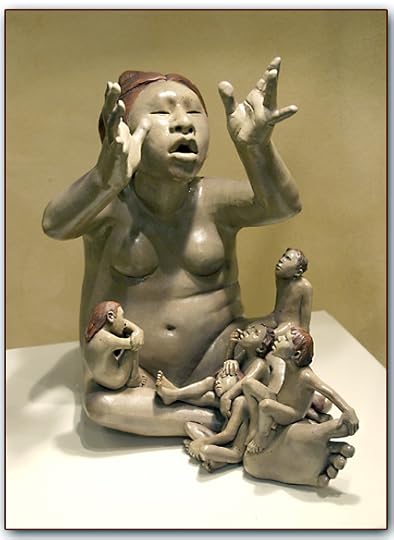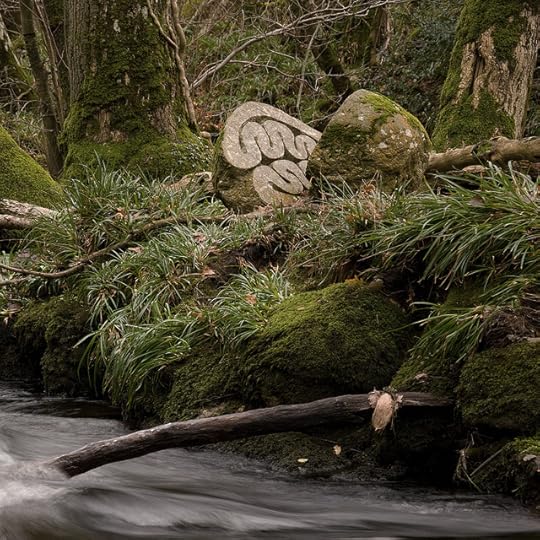Terri Windling's Blog, page 209
October 10, 2012
Circles and cycles
From A Branch from the Lightening Tree: Ecstatic Myth and the Grace in Wilderness
by Martin Shaw:
"A Culture of Wilderness...encourages longing, handling paradox, experiencing community in rowan trees and dark pools of water, carrying images of power back to the village, and flourishing in the process. A Culture of Wilderness is what initiation and myth offer.
"Our life is a house, with a roof of night-birds and muscled pillars of experience, its eaves containing a musky web of unique passions, its base holding a great fire that comes up from the very heart of the earth itself; around the house are hives of bees and orchards of apples. It is good to give some of the honey away and let in a few good-natured apple poachers. There is no short-cut to the building of such a house, but the garden is the legacy that instinctively arises through time and feeds others.
"All storytellers know that two types of time exist: one is the twenty-four hours, the school run, the bill-paying, forever catching-up time of our everyday world; but behind that looms the energy of mythic time, the great cycles that pulse from generation to generation. These great wheels infuse the everyday with nourishment, 'eternity in a grain of sand.' The philosopher Plotinus suggested that while the body favors a straight line, the soul hankers for the circle.
"This mythic, circular time (which is really no kind of time at all) laughs at the straight line and the alarm clock. Without it -- even with all the riches of the world -- we can enter the arena of the meaningless. As markets collapse and the world heats up, we would do well to see Coyote's claws opening holes between the two. We live in an era of tremendous possibility."
Photos above: "The Turning of the Seasons" -- our friend Eric's old shed and beehives on the village Allotments (viewed from the edge of the woods) during summer, autumn, winter, and spring.
Birds and Bees
From A Branch from the Lightening Tree: Ecstatic Myth and the Grace in Wilderness
by Martin Shaw:
"A Culture of Wilderness...encourages longing, handling paradox, experiencing community in rowan trees and dark pools of water, carrying images of power back to the village, and flourishing in the process. A Culture of Wilderness is what initiation and myth offer.
"Our life is a house, with a roof of night-birds and muscled pillars of experience, its eaves containing a musky web of unique passions, its base holding a great fire that comes up from the very heart of the earth itself; around the house are hives of bees and orchards of apples. It is good to give some of the honey away and let in a few good-natured apple poachers. There is no short-cut to the building of such a house, but the garden is the legacy that instinctively arises through time and feeds others.
"All storytellers know that two types of time exist: one is the twenty-four hours, the school run, the bill-paying, forever catching-up time of our everyday world; but behind that looms the energy of mythic time, the great cycles that pulse from generation to generation. These great wheels infuse the everyday with nourishment, 'eternity in a grain of sand.' The philosopher Plotinus suggested that while the body favors a straight line, the soul hankers for the circle.
"This mythic, circular time (which is really no kind of time at all) laughs at the straight line and the alarm clock. Without it -- even with all the riches of the world -- we can enter the arena of the meaningless. As markets collapse and the world heats up, we would do well to see Coyote's claws opening holes between the two. We live in an era of tremendous possibility."
Photos above: "The Turning of the Seasons" -- an old shed and beehives at the edge of the village Allotments during summer, autumn, winter and spring.
October 9, 2012
On Your Desk
Here's the latest entry in the "On Your Desk" photo series, featuring the workspaces of writers, artists, and others in the Mythic Arts community. (If you'd like to contribute, there's information on how to do so at the end of this post.)
The photos today come from Katherine Langrish, the author of several magical books that all fans of mythic fiction should know: the enchanting "Troll Fell" trilogy, set in the Viking age (and collected in an omnibus edition, West of the Moon); Dark Angels (US title: Shadow Hunt), a gorgeous faery novel set on the Welsh border in the 12th century; and Forsaken, a haunting, lyrical novel based on Scandinavian mermaid lore. She also writes a terrific blog, Seven Miles of Steel Thistles; contributes to The History Girls and An Awfully Big Blog Adventure; and she's the folklore editor for the online fairy tale journal Unsettling Wonder. Her most recent tale (about London under water) has just been published in the YA dystopian anthology After.
Katherine grew up in the Yorkshire Dales and now lives in the Oxfordshire countryside. She tells the story of how we first met here...and I'm so very glad that we did!
The pictures above and below show Kath's writing den in a house overflowing with books, music, and art:
"The first picture," she says, "shows my desk and
workroom in a (rare) tidy state, with some of the bookshelves, and
the curtains drawn to keep out the morning sun. I always work with the curtains drawn to get a better light on the
screen. I enjoy the way the light glows
through these curtains, with their design of old fans, which have been
mine since I was a little girl. Our next door neighbour passed them
over the fence to my mother, and (aged seven) I loved them so much I
made up a poem about them:
I have got
New fan curtains,
New fan curtains,
New fan curtains!
I have got
New fan curtains,
Hooray, hooray, hooray!
"If a poem is defined as a perfect expression of your feelings, this is probably the best I ever wrote.
"On the windowsill is
an Indonesian shadow puppet who gets the sunshine I decline.
"Up in the top right-hand
corner of my room, sinister Mr Fox dangles with an enigmatic grin in
front of an Escher print called ‘Three Worlds,’ where a fish
turns slowly under a reflective surface dotted with the curled boats
of fallen leaves, and upside-down trees reach long black fingers into
the depths. I write fantasy, which is also a mysterious mirror to our
world. The world is water. The world is air. The interface where
they meet is an almost non-existent membrane of a world, containing
and transforming both. As for the fox, one of my favourite
fairytales to tell aloud is the English tale of Lady Mary and Mr Fox.
Be bold, be bold, but not too bold…
"Here, on the left, is my cluttered wall space, a pin board with all kinds
of notes on it, and above it a magical David Wyatt pen and ink
drawing of trolls, the chapter heading illustration for the British
edition of my first book, ‘Troll Fell’.
"The map beneath it is a
version of London, showing the extent of flooding you’d get if sea
levels rose by fifty feet. The Thames would be three miles wide in
the centre of the city. That’s all part of the background research
for my work-in-progress (whose main characters appear in a story
called ‘Visiting Nelson’ published in Ellen and Terri’s new
anthology After).
"On the right: books, books, books…. This
is why I find it hard to write anywhere but here in my den. I’m
forever pulling books down, checking, consulting, getting
inspirations.
"Below: a more truthful
picture of my desk: the muddle and clutter that shows work really
being done."
All readers of this blog are
welcome to contribute to the "On Your Desk" series. You'll find more
information (and the address where you should send your photos) in
the first post of the series. Please view the full series to get an idea of what kind of material to send in. If you've already contributed to the series, but you've changed your workspace, you are welcome to contribute again.
October 8, 2012
Sky, stone, and the turning seasons
From A Branch from the Lightening Tree: Ecstatic Myth and the Grace in Wilderness
by Martin Shaw:
"To be in touch with wilderness is to have stepped past the proud cattle of the field and wandered far from the twinkles of the Inn's fire. To have sensed something sublime in the life/death/life movement of the seasons, to know that contained in you is the knowledge to pull the sword from the stone and to live well in fierce woods in deep winter.
"Wilderness is a form of sophistication, because it carries within it
true knowledge of our place in the world. It doesn't exclude
civilization but prowls through it, knowing when to attend to the needs
of the committee and when to drink from a moonlit lake. It will wear a
suit and tie when it has to, but refuses to trim its talons or whiskers.
Its sensing nature is not afraid of emotion: the old stories are are
full of grief forests and triumphant returns, banquets and bridges of
thorns. Myth tells us that the full gamut of feeling is to be
experienced.
"Wilderness is the capacity to go into joy, sorrow, and anger fully and stay there for as long as needed, regardless of what anyone else thinks. Sometimes, as Lorca says, it means 'get down on all fours for twenty centuries and eat the grasses of the cemetaries.' Wilderness carries sobriety as well as exuberance, and has allowed loss to mark its face."
October 7, 2012
Tunes for a Monday Morning
Here are two more strong performances from Music Fog's Americana music series.
Above: "God Loves Me," from Canadian singer/songwriter Melissa McClelland -- a dark tune with just a hint of Three Penny Opera about it, performed here with fellow-Canadian Luke Doucet.
Below, "Absence," from Carrie Rodriguez, a Mexican-American singer/songwriter out of Texas. She's performing here with Hans Holzen, originally from Nashville, now based in Brooklyn.
October 4, 2012
Flu and feasts
I'm down with a relapse of flu, and will be back on Monday. In the meantime, be sure to check out all the new dishes added to the "Mother Tongue" Moveable Feast, on the entwined subjects of land, language, art, and storytelling. I also recommend a lovely new piece by Mark Helprin on "Bumping Into Characters," in The New York Times.
Speaking of feasting, we're so proud of our daughter, Victoria Windling-Gayton, for being part of the talented team of chefs under Alyn Williams at the Westbury all this past year -- for their skill, dedication, and hard, hard work has just been rewarded with a Michelin star. The restaurant opened in the Mayfair section of London in the autumn of 2011, and to win this prestigious star in their first year is an extraordinary achievement. Congratulations to Alyn, to Victoria, and to the whole 2011/2012 AW team!
Art above: "Wedding Feast in a Barn" by Brueghel, Pieter (the Younger)
October 3, 2012
Wild Mercy
Well, my "Terry Tempest Williams Week" has turned into something more like a "Terry Tempest Williams Month," so here's one final quote before I move on to other things -- like the "On Your Desk" photos I keep promising you.
This quote, too, comes from the essay collection Red, and it slays me each time I read it:
"The eyes of the future are looking back at us and they are praying for us to see beyond our own time. They are kneeling with hands clasped that we might act with restraint, that we might leave room for the life that is destined to come. To protect what is wild is to protect what is gentle. Perhaps the wilderness we fear is the pause between our own heartbeats, the silent space that says we live only by grace. Wilderness lives by this same grace. Wild mercy is in our hands."
And indeed, it is.
October 2, 2012
Touching the source
From "A Letter to Deb Clow" by Terry Tempest Williams:
"I write to make peace with the things I cannot control. I write to create red in a world that often appears black and white. I write to discover. I write to uncover. I write to meet my ghosts. I write to begin a dialogue. I write to imagine things differently and in imagining things differently perhaps the world will change. I write to honor beauty. I write to correspond with my friends. I write as a daily act of improvisation. I write because it creates my composure. I write against power and for democracy. I write myself out of my nightmares and into my dreams. I write in a solitude born out of community. I write to the questions that shatter my sleep. I write to the answers that keep me complacent. I write to remember. I write to forget....
"I write because I believe in words. I write because I do not believe in words. I write because it is a dance with paradox. I write because you can play on the page like a child left alone in sand. I write because it belongs to the force of the moon: high tide, low tide. I write because it is the way I take long walks. I write as a bow to wilderness. I write because I believe it can create a path in darkness....

"I write as ritual. I write because I am not employable. I write out of my inconsistencies. I write because then I do not have to speak. I write with the colors of memory. I write as a witness to what I have seen. I write as a witness to what I imagine....
"I write because it is dangerous, a bloody risk, like love, to form the words, to say the words, to touch the source, to be touched, to reveal how vulnerable we are, how transient we are. I write as though I am whispering in the ear of the one I love."
The sculptures above are by Roxanne Swentzell, from the Santa Clara Pueblo in New Mexico. The pieces here are "Emergence of Clowns," "Making Oneself," "Storyteller," "Fruitful," and "Held." Please visit the artist's website to see more of her remarkable work in clay, glass, and bronze.
The quoted text from "A Letter to Deb Clow" comes from Terry Tempest Williams' essay collection Red: Passion and Patience in the Desert (Pantheon, 2001). I highly recommend seeking out the whole piece. It's simply gorgeous.
October 1, 2012
Asking questions
From Letters to a Young Poet by Rainer Maria Rilke:
“Be patient toward all that is unsolved in your heart and try to
love the questions themselves, like locked rooms and like books that are
now written in a very foreign tongue. Do not now seek the answers,
which cannot be given you because you would not be able to live them.
And the point is, to live everything. Live the questions now. Perhaps
you will then gradually, without noticing it, live along some distant
day into the answer.”
From three interviews published in A Voice in the Wilderness: Conversations with Terry Tempest Williams, edited by Michael Austin:
Scott London: You've said that your writing is a response to questions.
Terry Tempest Williams: I think about Rilke, who said that it's the questions that move us, not the answers. As a writer I believe it is our task, our responsibility, to hold the mirror up to social injustices that we see and to create a prayer of beauty. The questions serve us in that capacity. Pico Iyer describes his writing as "intimate letters to a stranger," and I think that is what the writing process is. It begins with a question, and then you follow this path of exploration.
Tom Lynch: I think a lot of nature writers struggle
with the issue of audience. It is easy to write to the converted, to
those who read environmental publications and seek out nature writing.
But there is also a great need to reach people who would never seek out
this sort of writing, to do the hard work of conversion, as it were. How
do you see yourself negotiating this problem?
Terry Tempest Williams: I honestly don't think much about
"negotiating the problem" of audience. As I said earlier, I write out of
my questions. Hopefully, if we write out of our humanity, our
vulnerable nature, then some chord is struck with a reader and we touch
on the page. I know that is why I read, to find those parts of myself in
a story that I cannot turn away from. The writers who move me are the
ones who create beauty and truth out of their sufferings, their yearnings,
their discoveries. It is what I call the patience of words born out of
the search.
Terry Tempest Williams: Perhaps as writers we are really
storytellers, finding that golden thread that connects us to the past,
present, and future at once. I love language and landscape. For me,
writing is the correspondence between these two passions. It is difficult to ever see yourself. I don't know how I've
developed or grown as a writer. I hope I am continuing to take risks on
the page. I hope I am continuing to ask the hard questions of myself. If
we are attentive to the world and to those around us, I believe we will
be attentive on the page. Writing is about presence. I want to be fully
present wherever I am, alive to the pulse just beneath the skin. I want
to dare to speak "the language women speak when there's no one around
to correct them." *
The extraordinary sculpture above is by Peter Randall-Page, who lives in the next village over from ours. The first two pieces can be found in the woodland landscape between Chagford and Drewsteignton: by the River Teign and in the Whiddon Deer Park. The final piece, "The Fruit Gatherers," is in Nottinghamshire, and was inspired by an Edward Curtis photograph depicting three Saguro Indian women carrying large baskets on their heads.
* Terry Tempest Williams is quoting the French feminist writer Hélène Cixous.
September 30, 2012
Tunes for a Monday Morning
Today's tunes come from The Trishas, out of Austin, Texas.
Above, a Kevin Welch song: "To Old to Die." Below, one of their own:"Dusty Shoes."The videos are part of the Music Fog project, celebrating the Americana music scene.
The final piece is a music video for "Drive," a single track that the band released last year. This video never fails to make me miss the dusty roads of the American southwest, and my battered old pickup truck in Tucson....
Terri Windling's Blog
- Terri Windling's profile
- 707 followers



















